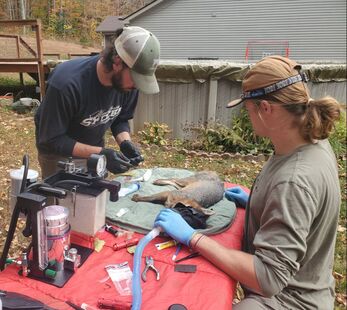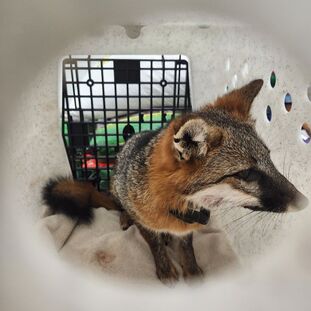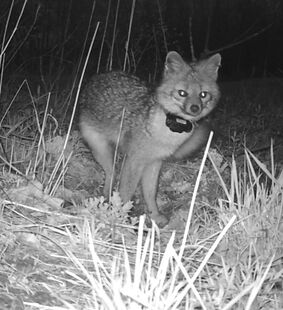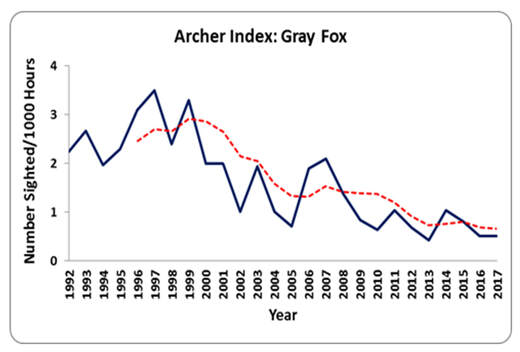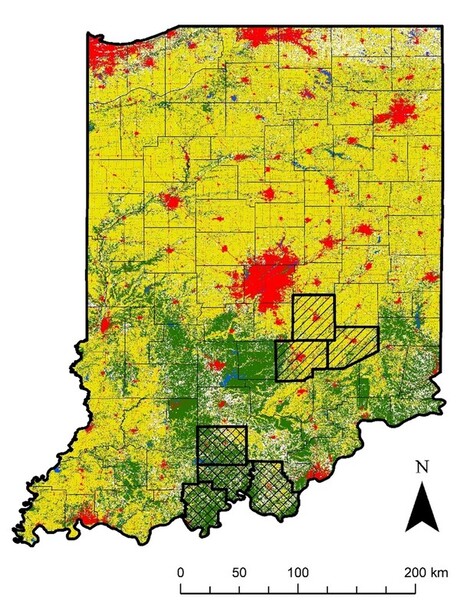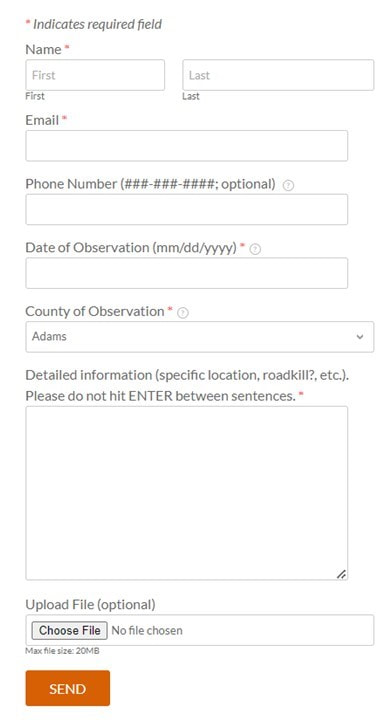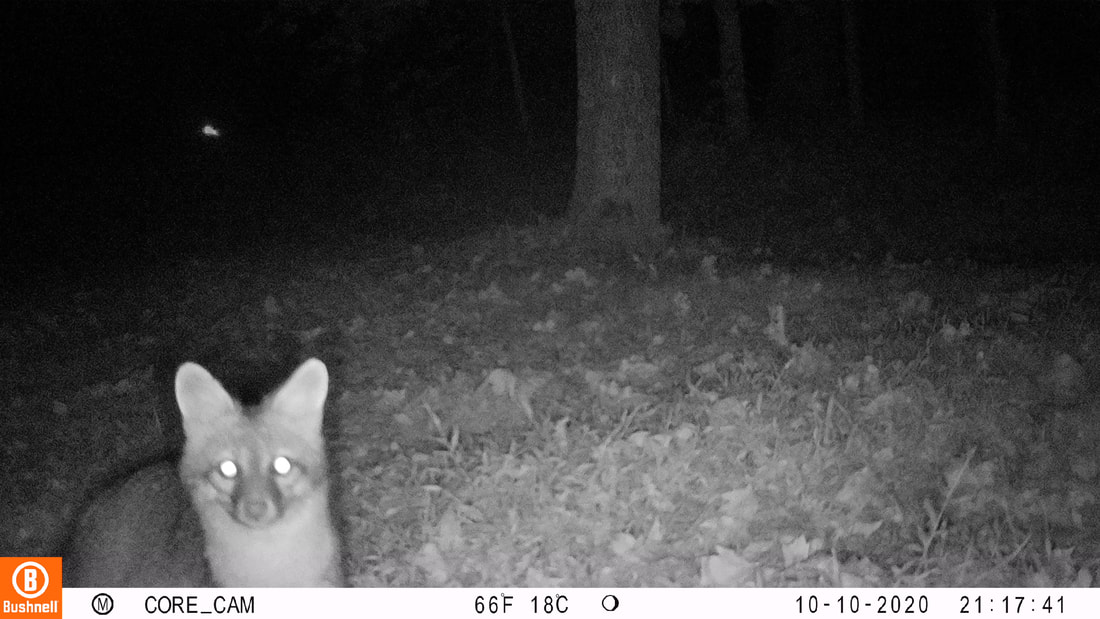Factors Affecting Gray Fox Populations and Distribution in Indiana
(2020-2024)
(2020-2024)
Spring 2023 Update:
- We are in our third year of the project, and are transitioning from several components of field-data collection to data analyses.
- We have closed our online submission form for observations of gray foxes. Citizens submitted 258 observations across 69 of the 92 counties in Indiana. Not all observations were of gray foxes, but we were able to confirm many observations through images and videos. These observation data aided us not only throughout the project, but also for our next step of modeling potential habitat for gray foxes in Indiana. Thank you!
- We have completed our capture efforts and our payment program for trappers that captured a gray fox that we could collar and release, and also for anyone submitting a gray fox carcasses from within Indiana. Thank you, especially to the trappers in Indiana!
- We will continue to monitor our GPS-collared gray foxes for the next several months. Stay tuned!
A big part of our project includes capturing, GPS-collaring, and collected lots of data from captured gray foxes. Once captured, gray foxes are chemically immobilized for handling, collaring, and data collection. Then, foxes recover in a heavy-duty dog kennel and released at the capture location. GPS collars allow us to collect lots of locations (and other data) of these gray foxes, providing a wealth of ecological information for us to analyze and interpret.
|
Gray foxes are a valuable and understudied furbearer not only in Indiana, but generally across its entire range. Several indices suggest range contractions not only in Indiana, but also other Midwest states. The factor(s) causing these distributional changes is unknown, but may be linked to habitat loss and fragmentation, changing mesocarnivore (e.g., coyote) community structure, disease, and other factors, and likely is a complex relationship among these factors. During 2020–2024, we are implementing a large-scale, comprehensive study at two study sites in Indiana, with objectives designed to directly assess causes of population changes of gray foxes, and to provide recommendations for management of this species that can be applied in Indiana, but also other Midwest states.
Geriann Albers (Indiana Department of Natural Resources) and Dr. Dawn Reding (Luther College) are providing critical expertise as collaborators on this project. Based on observations obtained during the archer index, there is evidence of a long-term declining trend in the statewide population of gray foxes in Indiana.
|
Our project study area includes two study sites: central (Bartholomew, Decatur, Shelby, and recently added Jennings counties; primarily agriculture and private lands) and southern (Crawford, Harrison, Orange, and Perry counties; primarily forested with public lands) Indiana, USA. Red = all developed-area cover types, yellow = cultivated crops, and green = all forest-cover types. |
What does this substantial effort include?
- Capturing and GPS-collaring gray foxes in two multi-count study sites in Indiana
- Assessing survivorship and cause-specific mortality, including an attempt to assess pup survival
- Determining space use and habitat selection of gray foxes
- Modeling potential gray fox habitat in Indiana using Maxent software
- Assessing diseases and parasites of gray foxes
- Conducting diet analysis
- Evaluating gene flow and identifying potential genetic barriers
Learn more about gray foxes in Indiana on the Indiana Department of Natural Resources web page here.
Gray Fox Observation Form (Indiana)
Please include detailed information about your observation (date, specific location, etc.)
Please include detailed information about your observation (date, specific location, etc.)
**PROJECT COMPONENT COMPLETED AND FORM NO LONGER ACTIVE - THANK YOU!**
Here's a couple of our first detections of gray foxes on the project, on our southern Indiana study site. Remember to watch the video using Full Screen!
Gray Fox Project Hotline = (812) 343-8350
**PROJECT COMPONENT COMPLETED AND HOTLINE NO LONGER ACTIVE - THANK YOU!**
Use the Hotline if
We make every effort to answer the Hotline immediately, especially because you may have a live captured gray fox for us. If we do not answer, please leave a voicemail and we will return your call as soon as possible.
- You are a trapper and you have captured a gray fox alive that we can radio-collar and release. If the fox is releasable, we will pay you $125.00/fox, which increased starting fall 2022. This is limited to our central (Bartholomew, Decatur, Shelby, and Jennings counties) and southern (Crawford, Harrison, Orange, and Perry counties) study sites.
- You are a trapper and have captured a gray fox anywhere in Indiana and are willing to sell the carcass (with or without pelt) to us. We will pay you $25.00/carcass.
We make every effort to answer the Hotline immediately, especially because you may have a live captured gray fox for us. If we do not answer, please leave a voicemail and we will return your call as soon as possible.
Project Partners
Additional Supporters
Copyright 2024 Wildlife Ecology Institute
